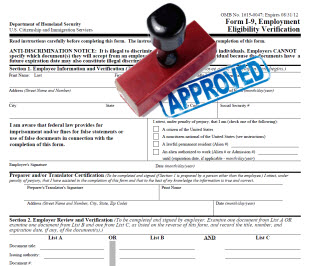The most common I-9 mistakes are:
- The employee fails to sign and date the attestation.
- The employer fails to have the employee complete Section 1 by the first day of employment (that is, the first day for pay).
- The employee doesn’t check the box indicating status (e.g., U.S citizen, lawful permanent resident), or the employee checks multiple boxes.
- The translator or preparer doesn’t complete the preparer box.
- The employer fails to enter acceptable documents on the form, including the document number and title, issuing agency, and expiration date.
- The employer demands certain documents (e.g., social security card).
- The employer does not complete Section 2 by the third day of employment.
- The employer fails to enter the date of hire. This date should match the date on payroll records,
- The employer representative does not sign, date, and print his or her name on the certification.
What if the Employee’s Documentation Doesn’t Look Right?
The standard is reasonableness, does the document reasonably appear to be genuine and relate to the employee? You are not expected to be a document expert. If the document does not appear to be genuine, reject the document and ask for another document on the list. What if the documents presented do not exactly match what the employee writes on the Form I-9 ( For example, the name is spelled differently.)? Ask the employee about the discrepancy. If the document appears genuine, ask the employee to correct the Form I-9 and initial the change or provide a corrected document.
The Form I-9 is available in Spanish, but you can’t use the Spanish version except in Puerto Rico. However, you may use the Spanish version as a translation aid when filling out the English version.
Caveat: You may engage an outside firm to do your Form I-9 work but remember that that doesn’t shift the responsibility for Form I-9 management—that remains with the employer.
Reference: Tsai, V, (2014). The 9 Most Common Form I-9 Mistakes, Holland & Hart LLP

